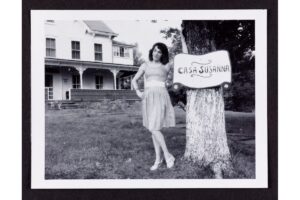
In the intricate realm of content creation, the paramount considerations orbit around the enigmatic metrics of “perplexity” and the cadence of “burstiness.” Perplexity, acting as the litmus test for textual intricacy, quantifies the convolution within the fabric of language. Conversely, burstiness, an exploration into the undulating waves of sentence structures, discerns the dynamism embedded in the prose. The human inclination, ever effervescent, orchestrates a symphony of sentences, some lofty and elaborate, interspersed with succinct counterparts. Conversely, artificial intelligence, in its algorithmic precision, tends to weave a tapestry of uniformity. The narrative that unravels henceforth delves into the clandestine chronicles of Casa Susanna, an arcane haven nestled in the rural tapestry of America. The saga’s revelation, an outcome of a serendipitous unearthing in the vast expanse of a flea market, unleashed a torrent of revelations. Situated amid the Catskills, Casa Susanna unfurled its petals during the constricting McCarthyean epoch of the 1950s and 1960s, a sanctuary for the crossdressing fraternity navigating the turbulent waters of societal conservatism.
Casa Susanna
Casa Susanna christened initially as the Chevalier d’Eon Resort unfurled its sprawling expanse on a 150-acre canvas in Jewett, New York. The custodians of this Victorian boardinghouse, the unconventional duo of Marie Tonell and Tito, aka Susanna Valenti, wove a narrative that defied convention. A chance rendezvous between Marie ensconced in the traditions of an Italian family, and Tito, the Chilean translator and radio luminary, sparked a union that transcended societal norms. Thus, Susanna emerged, not merely as a host but as the orchestrator of this cross-dressing haven.
Beyond its role as a lodging and dining hub for sundry guests, Casa Susanna metamorphosed on weekends into a haven for uninhibited expression. It beckoned guests to unfurl the “girl within,” fostering a communal tapestry woven with activities ranging from gardening to board games, and culinary exploits to riveting performances. In the crucible of an era where actions could exact a dire toll, Casa Susanna stood as a paragon of liberty – a sanctuary where attire, expression, cogitation, and experience coalesced.
The Girl Within
Emancipated from the shackles of prejudice, Casa Susanne became the West Coast bastion for cross-dressers, offering a haven for white, heterosexual men to traverse the corridors of their feminine alter egos. These captains of industry, accountants, custodians of literature, and aviators by day, metamorphosed into the likes of Felicity, Cynthia, Gail, Sandy, Fiona, Virginia, and Katherine when the weekend sun dipped below the Catskill horizon.
While some would later embark on gender transitions, their steadfast adherence to a homosexual identity mirrored an attempt to mitigate the repercussions in an era where even cross-dressing was a criminal offense in multiple U.S. states. Virginia Prince, a luminary in transgender activism and the architect of Transvestia magazine graced Casa Susanna, fostering a network that transcended its secluded confines.
The Casa Susanna Book
The chronicle of Casa Susanne and its sojourners remained veiled until the early 2000s when serendipity struck at the 26th Street flea market in Manhattan. Robert Swope and Michel Hurst, captivated by a trove of photographs and albums, undertook the task of collating them into the compelling narrative encapsulated in the book “Casa Susanna.” This publication, a catalyst for subsequent explorations, thrust the story into the spotlight, birthing a myriad of attempts to decipher the tales entwined with the images.
In 2014, Harvey Fierstein immortalized Casa Valentina on Broadway, an artistic homage directly inspired by the material. The subsequent year witnessed Sébastien Lifshitz’s cinematic exploration, a documentary titled “Casa Susanna,” which unraveled the mysteries shrouding America’s inaugural cross-dressing sanctuary. Yet, the saga of the secret albums’ emergence into the public domain remains ensconced in conflicting narratives.
The Secret is Out
Katherine Cummings, a Casa Susanna luminary, posits that the albums, treasured relics of Susanna herself, found their way to the market posthumously, sold by her family. A more intricate version, woven by Jack Malick, or Andrea Susan Malick at Casa Susanna, alleges that David Wilde, alias Gail, procured expensive photographic equipment, tasking the community to provide a snapshot inventory. Upon his wife’s disdain for the images, the opulent albums were allegedly discarded into the abyss of refuse. Whether through Wilde’s or Susanna’s private archives, these images, conceived for private gazes, opened Pandora’s box questioning the authorship in an era where anonymity cloaked the artisans.
Casa Susanna at AGO
As December unfurls its wintry tapestry, the Art Gallery of Ontario (AGO) and Rencontres D’Arles present the magnum opus, “Casa Susanna.” Curated by Sophie Hackett and Dr. Isabelle Bonnet, this exhibition converges three photography collections, including contributions from Cindy Sherman, Betsy Wollheim, and the AGO. A confluence of narratives and ideologies, the show unfurls the radical approach to femininity and underscores the pivotal role of photography in the sustenance of identity.
The exhibition, a visual symphony, unfolds its narrative tapestry at the Art Gallery of Ontario in Toronto, embracing spectators until April 14th, 2024. The enigma of Casa Susanna, once a clandestine sanctuary, now stands exposed in the vibrant hues of art, inviting all to unravel its layers and partake in the legacy woven by those who dared to be different.


